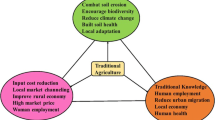Abstract
An inventory of plant species was conducted on farms, farm boundaries and homesteads in the Kilimanjaro agroforestry system. The survey covered 30 farms in 6 villages in Hai District on the slopes of Mount Kilimanjaro, Tanzania. Over 100 plant species spread over 40 families were identified and their uses obtained through interviews with farmers. The species identified include 53 tree species, 29 food crop species, 21 non-woody plants of economic value and 8 weed species. The food crops, trees and other economically useful plants are carefully chosen by the local farmers and intimately intercropped on the same unit of land. In most cases, the plants had two or more uses of which food, fuelwood, medicine, poles, timber and fodder were the most important.
Similar content being viewed by others
References
Andrews DJ (1974) Response of sorghum varieties to intercropping. Expl Agric 10:57–63
Arnold JEM and Jongma J (1978) Fuelwood and charcoal in developing countries. Unasylva 29:2–9
Chandler T and Spurgeon D (eds) (1979) International Cooperation in Agroforestry. Nairobi. 469 p
Fernandes ECM, O'Kting'ati and Maghembe JA (1984) The Chagga homegardens: A multistoried agroforestry cropping system on Mt. Kilimanjaro, Northern Tanzania. Agroforestry Systems (in press)
Hoekstra D and Kuguru FM (eds) (1983) Agroforestry Systems for Small-Scale Farmers: Proceedings of a Workshop. ICRAF/BAT, Nairobi. 283 p
ICRAF (1983) A global inventory of agroforestry systems: a project announcement. Agroforestry Systems 1:269–273
Keswani CL and Ndunguru BJ (1982) Intercropping. Proceedings of the second symposium on intercropping in semi-arid areas. IDRC-186e. Ottawa. 168 p
Mann HS and Saxena SK (1980) Khejri (Prosopis cineraria) in the Indian Desert. Central Arid Zone Research Institute, Jodhpur. 77 p
McDonald LH (ed) (1982) Agroforestry in the African Humid Tropics. United Nations University, Tokyo. 163 p
Mlambiti EM, Eldelsten P and Colyer D (1982) Economic analysis of the traditional farming systems of the Kilimanjaro Region, Tanzania. IAF Publication. West Virginia Agricultural and Forestry Experiment Station, Morgantown, West Virginia. 57 p
Mongi HO and Huxley PA (eds) (1979) Soils Research in Agroforestry: Proceedings of an Expert Consultation. ICRAF, Nairobi. 584 p
Monyo JH, Ker ADR and Campbell M (eds) (1976) Intercropping in Semi-Arid Areas. Proceedings of a Symposium. IDRC, Ottawa. 76 p
Nair PKR (1983) Tree integration on farmlands for sustained productivity of smallholdings. In: Lockeretz W (ed) Environmentally Sound Agriculture, pp. 333–350. Praeger Pub., New York.
Rao MR and Wiley RW (1980) Evaluation of yield stability in intercropping. Studies on sorghum/pigeon pea. Expl. Agric. 16:105–116
Tanzania Bureau of Statistics (1979) Population Census of 1978. TBS Dar es Salaam.
Wiersum KF 1982. Tree gardening and taungya on Java: Examples of agroforestry techniques in the humid tropics. Agroforestry Systems 1:53–70.
Author information
Authors and Affiliations
Rights and permissions
About this article
Cite this article
O'kting'ati, A., Maghembe, J.A., Fernandes, E.C.M. et al. Plant species in the Kilimanjaro agroforestry system. Agroforest Syst 2, 177–186 (1984). https://doi.org/10.1007/BF00147032
Published:
Issue Date:
DOI: https://doi.org/10.1007/BF00147032




